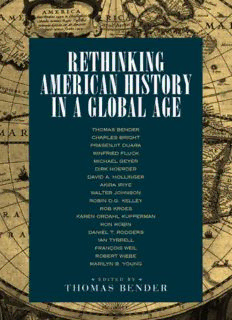
Rethinking American History in a Global Age PDF
Preview Rethinking American History in a Global Age
Rethinking American History in a Global Age Rethinking American History in a Global Age EDITED BY Thomas Bender U N I V E R S I T Y O F C A L I F O R N I A P R E S S Berkeley LosAngeles London UniversityofCaliforniaPress BerkeleyandLosAngeles,California UniversityofCaliforniaPress,Ltd. London,England (cid:1)2002bytheRegentsoftheUniversityofCalifornia LibraryofCongressCataloging-in-PublicationData RethinkingAmericanhistoryinaglobalage/editedbyThomasBender. p. cm. Includesindex. ISBN0-520-23057-4(cloth:alk.paper).—ISBN0-520-23058-2(paper: alk.paper) 1.UnitedStates—Historiography. 2.UnitedStates—History— Philosophy. 3.Globalization. I.Bender,Thomas. E175.R482001 973'.07'2—dc21 2001002388 ManufacturedintheUnitedStatesofAmerica 10 09 08 07 06 05 04 03 02 01 10 9 8 7 6 5 4 3 2 1 Thepaperusedinthispublicationisbothacid-freeandtotallychlorine-free(TCF).Itmeets theminimumrequirementsofANSI/NISOZ39.48-1992(R1997)(PermanenceofPaper). CONTENTS preface / vi Introduction. Historians,theNation,andthePlenitudeofNarratives ThomasBender / 1 PART I•HISTORICIZING THE NATION / 23 1. TransnationalismandtheChallengetoNationalHistories PrasenjitDuara / 25 2. InternationalizingInternationalHistory AkiraIriye / 47 3. WhereintheWorldIsAmerica?TheHistory oftheUnitedStatesintheGlobalAge CharlesBrightandMichaelGeyer / 63 PART II•NEW HISTORICAL GEOGRAPHIES AND TEMPORALITIES / 101 4. InternationalattheCreation:EarlyModernAmericanHistory KarenOrdahlKupperman / 103 5. HowtheWestWasOne:TheAfricanDiaspora andtheRe-MappingofU.S.History RobinD.G.Kelley / 123 6. TimeandRevolutioninAfricanAmerica:Temporality andtheHistoryofAtlanticSlavery WalterJohnson / 148 vi CONTENTS 7. BeyondtheViewfromEuro-America:Environment,SettlerSocieties, andtheInternationalizationofAmericanHistory IanTyrrell / 168 PART III•OPENING THE FRAME / 193 8. FromEuro-andAfro-AtlantictoPacificMigrationSystem:AComparative MigrationApproachtoNorthAmericanHistory DirkHoerder / 195 9. FramingU.S.History:Democracy,Nationalism,andSocialism RobertWiebe / 236 10. AnAgeofSocialPolitics DanielT.Rodgers / 250 11. TheAgeofGlobalPower MarilynB.Young / 274 12. AmericanEmpireandCulturalImperialism:AViewfromtheReceivingEnd RobKroes / 295 PART IV•THE CONSTRAINTS OF PRACTICE / 315 13. DoAmericanHistoricalNarrativesTravel? Franc¸oisWeil / 317 14. TheModernityofAmericaandthePracticeofScholarship WinfriedFluck / 343 15. TheExhaustionofEnclosures:ACritiqueofInternationalization RonRobin / 367 16. TheHistorian’sUseoftheUnitedStatesandViceVersa DavidA.Hollinger / 381 appendix. participants in the la pietra conferences, 1997–2000 / 397 contributors / 401 index / 405 PREFACE Modernhistoriographyisinextricablylinkedwiththemodernnation.That connectionhasbothgivenfocustohistoricalinquiryandwonforitaplace in civic life. But it has also been disabling, silencing stories both smaller andlargerthanthenation.Today,atthebeginningofthetwenty-firstcen- tury, in an era of intense discussion of multiculturalism and globalism, it may be easier than ever before to recognize the plenitude of historical experiencesand narratives imbricated in a national history. To historicize thenationistorelateitsdominantnarrative,itsnationalnarrative,toother narrativesthatrefertobothsmallerhistoriesandlargerones.Thatmeans understanding the historical production of the nation and locating it in a context larger than itself. That is the work of this volume. It asks a big question and begins the work of answering it: How does one frame the narrativeofAmericanhistoryinthecontextofaself-consciouslyglobalage? This book is the product of a complex collaborative project; many in- dividualsandinstitutionsthusdeservethanks.TheProjectonInternation- alizingtheStudyofAmericanHistoryinvolvedseventy-eightscholars,both fromtheUnitedStatesandabroad(listedintheappendix),andwasajoint endeavorofNewYorkUniversity,throughitsInternationalCenterforAd- vanced Studies, and the Organization of American Historians. It received enthusiasticsupport,valuablesuggestions,andgenerousfundingfromsev- eralfoundationsandinstitutions:TheGladysKriebelDelmasFoundation, particularly Patricia La Balme; The Rockefeller Foundation, particularly Lynn Szwaja and Thomas Ybarra Frausto; The Ford Foundation, particu- larly Alison Bernstein and Toby Volkman; The Andrew W. Mellon Foun- dation,particularlyRichardEkman;theAmericanCouncilofLearnedSo- cieties, particularly Stanley N. Katz and Steven Wheatley; and the Faculty vii viii PREFACE of Arts and Sciences at NYU, particularly Philip Furmanski, dean of the faculty. Holding the project’s conferences outside of the United States seemed symbolically to make an important point about the value of stepping out- sideofthenation,ifonlytemporarily,towriteafresheraccountofit.That fantasybecamereal,andpleasantlyso,in1997,whenNewYorkUniversity welcomed the first of the series of conferences to its campus in Florence, Italy, the extraordinarily beautiful and peaceful Villa La Pietra. Surely the consistently good spirits of the conference, even when conflicting points of view were being proposed, owed something to the Tuscan sun, the de- lightfulgardensofthevilla,andtheformalbutcomfortablemeetingrooms where we spent the better part of our days. For this opportunity, I wish to thank especially the late Debra James, vice president of New York Univer- sity,andCeciliaGuarnacciaatLaPietraitself. DavidThelenandLindaKerberwerequicktosupporttheideaforthis project when I first broached it, and they helped develop the first outline of the project, which was presented to the executive board of the Organi- zationofAmericanHistorians.Atthetimethisprojectbegan,LindaKerber waspresidentoftheOAH,andIwanttothankherbothforherwisecounsel at the beginning and her diplomatic skills at other times. Two past presi- dents and the two presidents-elect at the time of the establishment of the project were active and helpful participants, and I wish to thank Gary B. Nash, Eric Foner, George Fredrickson, and William H. Chafe. At the be- ginning,ArnitaJoneswasexecutivedirectoroftheOAH,andherassistance wasunstintingandinvaluable,aswasthatofJohnDichtlintheOAHoffice. Atthebeginningoftheproject,IwasNYU’sdeanforthehumanities,and my assistant, Shirley Riddell, was indispensable in getting the work under way. At the International Center for Advanced Studies, I wish to thank TanyaSerdiuk,whohelpedwiththelogisticsofthefirstconference;Saverio Giovacchini, for the second; Sula Haska, for the third; and Mark Elliott, forthefourth. Mainly, however, I want to thank all of the participants. I have never participatedinasingleconferencethatwassoconsistentlystimulating,let aloneaseriesoffourconferences.Specialfieldsandapproaches,different institutional locations and statuses, U.S. scholars and foreign scholars, re- searchuniversityfacultyandcommunitycollegeandhighschoolteachers, publichistorians,seniorleadersandgraduatestudentsbecameanintellec- tual community, recognizing one another as equals at the conference ta- ble—historians all, serious, committed, and civil. From among the very largenumberofexcellentpaperspresentedatthevariousconferences,this bookoffersaselectionthatcollectivelyandcoherentlyrepresentsthework oftheproject.Buteachdiscussionandeachpaper,writteninacumulative process,buildsuponeveryotherpaper,andIwanttothanktheauthorsof PREFACE ix both the papers in this book and those not included. All equally contrib- uted to the success of the project, even if practicality dictated that only someofthepaperscouldbepublished. The chapters that follow do not cover all aspects of the issue of inter- nationalizationnoralltheimportantthemesandperiodsofAmericanhis- tory. But they do cover a great deal, addressing many of the big issues in Americanhistoriography.Thedifferentsectionshavevaryingpurposesand different work to do within the context of the whole volume. Parts 1 and 2arethemosttheoretical.Moreover,theyareforthemostpartstatements of advocacy; they urge historians to consider a very different relationship to the nation and national history. The chapters in part 3 do rather than advocate. Put differently, they seek to exemplify the kind of history being urgedinthisvolume.Inpart4,thereisacertainsteppingback.Ifparts1 and 2 are unreservedly promoting a new kind of history, the chapters in part4arecautionary,urgingamoderatehistoriographicalrevolution.They raisehardquestionsaboutstructuresandconstraintsonchange,andthey warn against mischaracterizing traditional history and mistaking the di- mensionsofchange.Theyreaffirmthatthepointhereisnotapostnational historybutaricherandmorehistoricalnarrativeofthenation,moreclearly distinguishingwhatispartofthenationalhistorybuteitherlargeorsmaller thanthenation. Thehistoriographicalinnovationsbeingproposedhereareincremental and plural. The book does not advance a cut-and-burn approach to the historiographical past. The claim I would make for the volume is that it invitesourcolleaguestoconsideranewandimportantframing,orcontex- tualization,forthehistoryoftheUnitedStates.Itdoesnotspecifyasingle form for the new narratives implied by this reframing, but the ideas and examplesitoffersoughttoprovidesufficientorientationtothosewhorec- ognize the present opportunity, and, I would argue, obligation, to think afresh about the relation of the narratives we present to audiences in the UnitedStatesandabroadinourincreasinglyself-consciousglobalage. ThomasBender
Description: